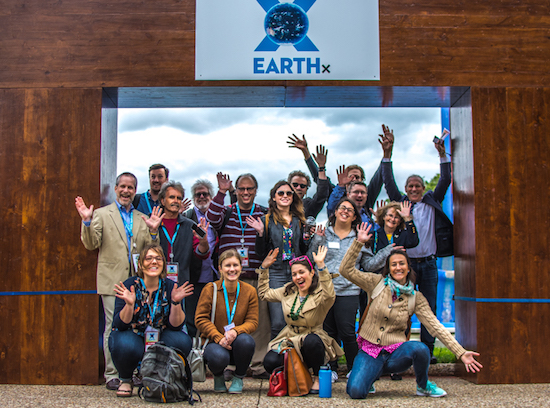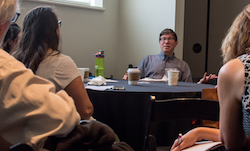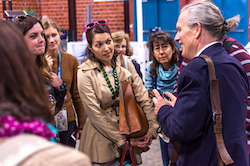SEJournal Online is the digital news magazine of the Society of Environmental Journalists. Learn more about SEJournal Online, including submission, subscription and advertising information.
 |
| Some of the 44 journalists who took part in an SEJ-sponsored environmental regulatory workshop hosted by Earth Day Texas in Dallas. Photo: Dale Willman |
SEJ News: Reporters Look Under Regulatory Hood at Dallas Workshop
[Editor's note: Find resources from the workshop in this toolbox.]
In short, Trump’s administration can better protect against losses in court if the agencies seek to enact watered-down regulations that look like actual regulations, rather than trying to opt out of regulation altogether. The devil is in the details, of course, but courts are far more deferential to agencies that provide a defensible decision than to those that simply deny a problem exists.
The SEJ program convened in parallel with the sprawling annual Earth Day Texas event whose founder, Dallas businessman Trammell Crow, funded the journalism workshop. The main attraction was an extended series of conversations with a team of veteran environmental legal experts who shared observations about the prospects for environmental regulation under the Trump administration — and about where smart reporters might dig up stories as trends unfold.
During one roundtable, for instance, Scott Fulton, president of the Environmental Law Institute, said among developments to watch closely would be the Trump administration’s effectiveness and speed of response to any significant environmental crises (think BP oil spill).
 |
| Attorney Sean Hecht of UCLA was one of several legal experts who met with reporters during the four-day workshop. Hecht warned that a mass exodus of EPA staff and the resulting loss of institutional memory would reduce enforcement and monitoring. Photo: Dale Willman |
He also advised reporters to track how the administration handles transparency. Are agency officials willing to disclose the people they meet with in closed-door settings? Does the agency go easy on enforcement with those entities?
Fulton, a former general counsel at the U.S. Environmental Protection Agency in the Obama administration, also suggested staying on top of delays in regulatory action by agencies like the EPA, which he said is already prone to fall behind on its obligations.
Another former Obama administration EPA official, Rob Verchick of Loyola University, offered similar insights. He suggested, for example, that stories were to be found in any politicizing of science, such as agency officials requesting adjustments to scientific findings. And Verchick pointed to possible story lines in listing of species and designation of critical habitats — or the lack thereof — under the Endangered Species Act, as well as energy development on public lands.
Verchick suggested other overarching themes that might frame environmental journalism reporting in the period ahead. Equity issues were one; that is, how shifting environmental policy might disproportionately affect the less economically advantaged. Verchick also recommended watching for “precipitous overreach,” in which policy makers push so far to rescind rules that they incite a litigation backlash.
The job of the journalist is to
cut through to the truth of the matter.
— Glenn Smith
Budget cuts at EPA also came up. Attorney Sean Hecht of UCLA suggested that the federal government could lose its capacity to act as an environmental regulator altogether, given the expected mass exodus of EPA staff. He argued the resulting loss of institutional memory would reduce enforcement and monitoring even though laws and regulations remain on the books.
Hecht was also one of two attorneys at the workshop zooming in on state-level environmental regulation. The second, Pamela Giblin, a partner at the Austin-based firm Baker Botts, who frequently represents industry interests, called on reporters to dispense with “stereotypes” about states like Texas as “bad actors.” She noted, for instance, that while Texas has some of the largest industrial concentrations in the country, the state had fewer non-attainment areas than California under ambient air standards of the Clean Air Act.
How journalists can avoid being ‘framed’
The workshop was not all insider nitty gritty. Reporters also delved into more conceptual matters with the help of cognitive scientist George Lakoff and journalist-turned-political-consultant Glenn Smith. They talked with participants about how environmental journalists could more effectively reach consumers who evidenced little faith in the news media and who often mold what they hear to what they already understand. This makes explanatory reporting about controversial issues a particular challenge.
| Cognitive scientist George Lakoff, right, and former journalist Glenn Smith, left, urged journalists to consider the "framework" through which news consumers read their stories. Photo: Dale Willman |
The power of language is key. “We’re taught that language is neutral. But that’s not true at all,” explained Lakoff. Word choices summon up a whole framework of ideas that helps news consumers fit new information with their pre-existing notions.
That makes it possible, Lakoff warned, for sources to manipulate these conceptual frameworks for political advantage. The case in point used during the workshop was EPA Administrator Scott Pruitt’s claim that there is a “debate” over human causation of climate change. At the same time, reporters can be made unwittingly complicit in those frames simply by repeating a source’s word choice.
Lakoff suggested that to better serve news consumers, reporters should begin their reports with “the relative truth you know,” before making reference to or using the terminology of competing frames. For instance, a report could refer to the overwhelming consensus about human-caused climate change before quoting Pruitt’s argument about “debate.”
Lakoff and Smith acknowledged that this is not the way journalism is typically taught, since what is “new” is usually what leads a story. But because of that, Smith said, sources will simply “say something new to manipulate the press.”
Nevertheless, Smith challenged reporters to think differently. “Journalists are given a certain kind of raw material to work with, such as quotes,” he said. “But almost everything someone tells you is self-serving. The job of the journalist is to cut through that to tell the story in a way the public can understand it, and that cuts through to the truth of the matter.”
Got a leaker? Do due diligence
The four-day program also had a generous dose of highly practical information for working environmental reporters.
One morning, for instance, featured a discussion with whistleblower experts. Among them was Tom Devine, legal director for the Government Accountability Project, a public interest law firm which he said has worked with more than 7,000 whistleblowers over more than 30 years.
It’s enticing once you have an
insider with documents
to run with it. But before you get in
too deep, set ground rules.
— Megan Rose
“This is a fascinating, complex subset of society,” Devine said of typical whistleblowers. “A person who is well-adjusted is not going to take on the power structure. It takes someone a little unusual to take on that risk. These are folks at the intersection of valid, but conflicting values.”
Megan Rose, who covers the military for ProPublica, talked about her practical experience fostering whistleblower relationships. She’s often asked how a journalist finds a leaker in the first place. “You don’t — they find you,” she explained. It is possible, however, to “tickle the wire” by publishing what you know, even if it’s that you know little, to see if that can arouse interest, Rose added.
But once you’ve been approached by a whistleblower, Rose recommends you “take a step back. It’s enticing once you have an insider with documents to run with it. But before you get in too deep, set ground rules.”
 |
| Earth Day Texas founder Trammell Crow, during a walkaround the event with environmental journalists attending the SEJ workshop. Photo: Dale Willman |
As part of the due diligence, Rose suggested reporters “confirm the goods [and] scrub your whistleblower.” Get something in writing from the source, in the form of a one-page pitch, about what they know and don’t. Find out what they’re risking by coming forward. Find out their track record with the company or agency, their motivations and so forth.
Most importantly, said Rose, “manage expectations at every step of the way.” That means preparing sources for what it means for a journalist to be involved, discussing the issue of exclusivity and of how the documents the source provides can and cannot be used in reporting. It also means making clear what aspects of the story you’ll focus on, as well as your reporting schedule and timeline. “Don’t let the process of being in the media be a black box.”
It may sound like a lot of work, but Rose advises, “Be patient. Long courtships can have big payoffs.”
The workshop also featured a rotating set of practical tools sessions one afternoon. Tim Wheeler, managing editor of Bay Journal and chair of the SEJ’s Freedom of Information Task Force, ran a program on FOIA searches. Eric Sagara, senior data reporter at Reveal, talked with reporters about database searching. And Adam Glenn, SEJournal editor, demonstrated a series of digital storytelling tools.
Audio:
- George Lakoff, Cognitive Scientist (34.6 MB / 50:19)
Videos:
- Scott Fulton, Environmental Law Institute
- Sean Hecht, UCLA
- Rob Verchick, Loyola University
* From the weekly news magazine SEJournal Online, Vol. 2, No. 18. Content from each new issue of SEJournal Online is available to the public via the SEJournal Online main page. Subscribe to the e-newsletter here. And see past issues of the SEJournal archived here.













 Advertisement
Advertisement 



